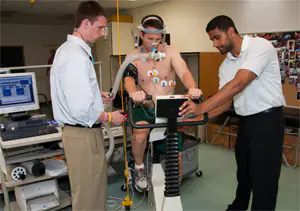Exercise bikes
Modern exercise bikes used in health centers, fitness clubs and bodybuilding gyms have a number of special service devices: for measuring CC (heart rate), RR (breathing rate), etc.
The founder of this class of sports cardio devices was the prototype "veloergometer VE-02", produced by the Kyiv production association "Avtoremont" back in Soviet times. Before describing its functionality, let's understand the question: “what is a bicycle ergometer?” and how is it fundamentally different from an exercise bike?
What is a bicycle ergometer?
In fact, a bicycle ergometer is the same “good old exercise bike,” but only equipped with an expanded range of diagnostic tools and a powerful microcomputer that allows you to accurately dose the load, continuously monitor your physical indicators, and select a training program for you here or another, depending on your level of fitness. , count the kilocalories, watts and joules spent, and so on and so forth. It can also constantly accumulate and accumulate all this information about you over a long period of use of the device, issue statistical reports, track trends, forecast and plan work for the future...
In fact, a bicycle ergometer is not so much a simulator, but rather a unique diagnostic tool with a wide range of capabilities designed to help doctors in the dispensary examination of observed patients. By the way, it was originally created exclusively for these tasks...
Nowadays, with the constant growth of technological progress and the constant improvement of this class of devices, the difference between a bicycle ergometer and an exercise bike has actually been completely erased. Nowadays, it’s probably impossible to find an exercise bike that doesn’t have a display and all sorts of other diagnostic stuffing...
But let’s return again to the “old man VE-02” we are considering. This device made it possible to accurately dose and smoothly regulate the load on the practitioner’s body over a wide range. The general view of the simulator is shown in Figure No. 1.
- The device could be used in a sitting or lying position when pedaling with your feet, and in a sitting position when pedaling with your hands. Moreover, for working on a bicycle ergometer in a lying position, the kit could include a special couch and a set of various pedals;
- The device had a movable cart in which the saddle, backrest and handrails were combined. In this case, the effort during work was concentrated on the back, and the hands of the student were freely located on the handrails.
Since the times of the USSR, the described exercise bike has been successfully used in:
- medicinal,
- therapeutic and prophylactic,
- health,
- and sports institutions.
Ski simulator
Figure 2 below shows a common type of sports device. "ski simulator", which effectively imitates the hand movements of a ski racer. The machine's motor drives two rubber bands located at a distance of approximately 80-100 centimeters from each other. The student, with ski poles in his hands, stands on the platform located on the top cover of the body and begins to imitate the movements of the hands of a ski racer, pushing off with the poles from the ribbons running towards him. Typically, rubber tips are placed on the tips of the sticks, which ensure reliable adhesion to the surface of the tapes and at the same time protect the tapes from damage.
On this device, you can simulate hand movements for any type of movement of a skier-racer: alternating, so-called two-step skiing, simultaneous or stepless and other variations... At the same time, the movements of the skier’s body are also practiced: bending and straightening, transferring the weight of the athlete’s body from one leg to another.
The speed of the belts is adjustable over a wide range, so you can simulate different amounts of deceleration and acceleration of movement.
Here are some exercises on this simulator:- From the “landing” position, move in a sliding step. The hands move passively and then are placed behind the back.
- Movement by performing several pushes in a row with one and then another ski (“scooter”),
- Sliding with a simultaneous stepless move with a smooth pendulum-like movement (back and forth) of the sticks.
- From a bent position, slowly straightening up and bringing the sticks forward, moving with a simultaneous two-step move.



